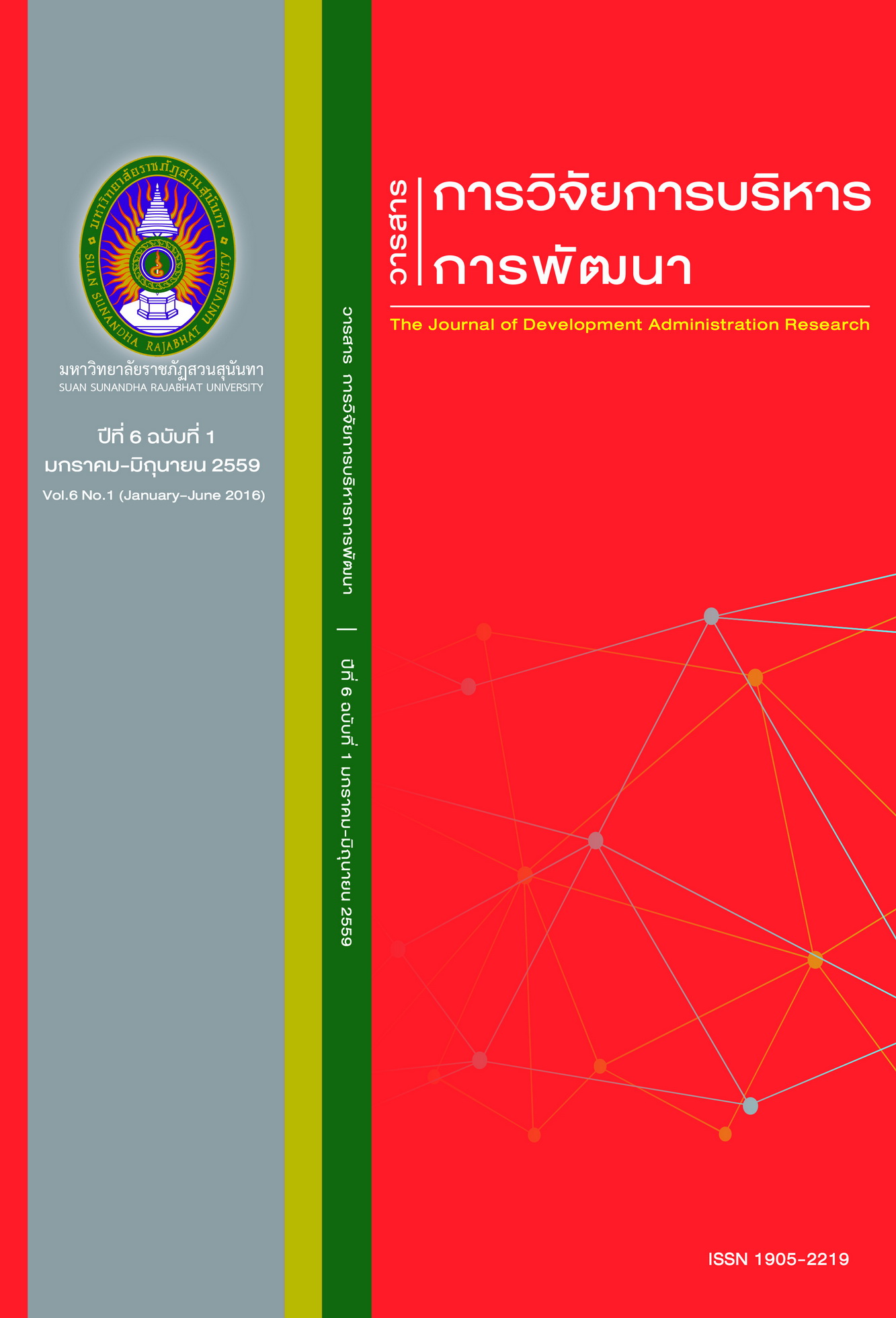ปัจจัยที่ส่งผลต่อความผูกพันของลูกจ้างในองค์กรธุรกิจครอบครัวอุตสาหกรรมเซรามิก จังหวัดลำปาง
คำสำคัญ:
ธุรกิจครอบครัว, ความผูกพันในองค์กร, อุตสาหกรรมเซรามิกบทคัดย่อ
การวิจัยครั้งนี้มีวัตถุประสงค์เพื่อศึกษาปัจจัยที่ส่งผลต่อความผูกพันของลูกจ้างในองค์กรธุรกิจครอบครัวอุตสาหกรรมเซรามิก จังหวัดลำปาง กลุ่มตัวอย่างที่ใช้ในการวิจัยเป็นลูกจ้างประจำที่ทำงานกับผู้ก่อตั้งอย่างน้อย 3 ปี และทำงานกับผู้สืบทอดอย่างน้อย 2 ปี จากโรงงานอุตสาหกรรมเซรามิกขนาดกลางและขนาดย่อมที่เป็นธุรกิจครอบครัวในจังหวัดลำปาง โดยกลุ่มตัวอย่างได้มาจากการสุ่มแบบหลายขั้นตอน (Multi-state Random Sampling) จำนวน 346 คน เครื่องมือที่ใช้ในการเก็บรวบรวมข้อมูลในครั้งนี้เป็นแบบสอบถาม วิเคราะห์ข้อมูลโดยหาค่าเฉลี่ย ส่วนเบี่ยงเบนมาตรฐาน การวิเคราะห์ความแปรปรวนทางเดียว การวิเคราะห์ค่าสัมประสิทธิ์สหสัมพันธ์แบบเพียร์สัน และการวิเคราะห์การถดถอยพหุคูณ และใช้โปรแกรม LISREL ผลการวิจัยพบว่า (1) การรับรู้ของลูกจ้างด้านศักยภาพของผู้สืบทอดและความน่าเชื่อถือของผู้นำ ที่ส่งผลต่อความผูกพันของลูกจ้างในองค์กรที่เป็นธุรกิจครอบครัวของอุตสาหกรรมเซรามิกจังหวัดลำปาง พบว่า ลูกจ้างมีการรับรู้ถึงปัจจัยด้านความน่าเชื่อถือของผู้ก่อตั้ง ศักยภาพของผู้สืบทอด ความน่าเชื่อถือของผู้สืบทอด และความผูกพันของลูกจ้างในองค์กรที่เป็นธุรกิจครอบครัวอุตสาหกรรมเซรามิกจังหวัดลำปาง อยู่ในระดับมาก ตามลำดับ (2) ปัจจัยความน่าเชื่อถือของผู้ก่อตั้ง ศักยภาพของผู้สืบทอด ความน่าเชื่อถือของผู้สืบทอด ที่ส่งผลต่อความผูกพันของลูกจ้างในองค์กรที่เป็นธุรกิจครอบครัวของอุตสาหกรรมเซรามิกจังหวัดลำปาง สามารถอธิบายถึงความแปรปรวนได้ร้อยละ 40.50, 55.50, 70.90 ตามลำดับ ที่สามารถพยากรณ์ถึงความผูกพันของลูกจ้างในองค์กรที่เป็นธุรกิจครอบครัวของอุตสาหกรรมเซรามิกจังหวัดลำปาง ได้อย่างมีนัยสำคัญทางสถิติที่ระดับ .05 (3) ความผูกพันของลูกจ้างในองค์กรที่เป็นธุรกิจครอบครัวของอุตสาหกรรมเซรามิกจังหวัดลำปาง ได้รับอิทธิพลทางตรงจากความน่าเชื่อถือของผู้ก่อตั้ง ศักยภาพของผู้สืบทอด และความน่าเชื่อถือของผู้สืบทอด ที่มีค่าสัมประสิทธิ์สหสัมพันธ์สามารถพยากรณ์ได้ร้อยละ 69 ส่วนความน่าเชื่อถือของผู้สืบทอด ยังได้รับอิทธิพลทางตรงจากความน่าเชื่อถือของผู้ก่อตั้ง และศักยภาพของผู้สืบทอดที่มีค่าสัมประสิทธิสหสัมพันธ์สามารถพยากรณ์ได้ร้อยละ 73 ตลอดจนศักยภาพของผู้สืบทอด ยังได้รับอิทธิพลทางตรงจากความน่าเชื่อถือของผู้ก่อตั้ง มีค่าสัมประสิทธิ์สหสัมพันธ์สามารถพยากรณ์ได้ร้อยละ 34
เอกสารอ้างอิง
สรรชัย เตียวประเสริฐกุล. (2550). ธุรกิจครอบครัวไม่ใช่เรื่องเล่น ๆ. Brand age Magazine, 8(สิงหาคม), 116-117.
สถาบันวิจัยสังคม, มหาวิทยาลัยเชียงใหม่. (2545). รายงานการศึกษาโครงการจัดทำแผนแม่บทอุตสาหกรรมราย (สาขาเซรามิคและแก้ว). เชียงใหม่: มหาวิทยาลัยเชียงใหม่.
สุชาติ ประสิทธิ์รัฐสินธุ์. (2546). ระเบียบวิธีการวิจัยทางสังคมศาสตร์. กรุงเทพมหานคร: เฟื่องฟ้าพริ้นติ้ง.
สุชาต ประสิทธิ์รัฐสินธุ์. (2549). แบบจำลองสมการโครงสร้าง: การใช้โปรแกรม LISREL, PRELIS และ SIMPLIS. กรุงเทพมหานคร: สามลดา.
Ashltrom, K. (1998). Governing the family-owned tnterprise: An interview with Finland’s Krister Ahlstrom. Harvard Business Review, 76(1), 112.
Becker, H. S. (1960). Notes on the concept of commitment. American Journal of Sociology, 14: 32-42.
Buchanan, I. I. (1974). Building organizational commitment. The socialization or Managers in work organizations. Journal of Business and Psychology, 9, 533-545.
Dyer, W. G., Jr., & Sanchez, M. (1998). Current state of family business theory and practice as reflected in Family Business Review 1988-1997. Family Business Review, 11(4): 287-290.
Fiorito, J. (2007). Organizational commitment, Human resource practices, and organizational characteristics. Journal of Managerial Issues, 19(2): 186-207.
Gordon, G. E., & Rosen, N. (1981). Critical factors in leadership succession. Organizational Behavior and Human Performance, 27(2): 227-234.
Handler, W. (1991). The succession experience of the next generation. Family Business Review, 5(3), 283-307.
Handler, W. (1989). Succession in family business: A review of the research. Family Business Review, 7(2): 133-157.
Kanter, R. M. (1977). Men and Women of the corporation. New York: Basic Book, Inc. Publishers.
Konnert, M. W., & Augenstein, J. J. (1990). The superintendency in the nineties; What spreintertendents and board members need to know. Lancaster: Technomic.
Kotler, P., & Armstrong, G. (2001). Principles of Marketing (12th ed.). Englewood Cliffs, NJ: Prentice-Hall.
Kouze, J. M., & Posner, B. Z. (1993). The leadership challenge (2nd ed.). San Francisco: Jossey-Bass Publishers.
Lansberg, Ivan. (1988). The succession conspiracy. Family Business Review, 1(2): 119-144.
Meyer, J. P. (1993). Commitment to organizations and occupations: Extension and test of a three-component conceptualization. Journal of Applied Psychology, 78: 538-551.
Meyer, J. P., & Allen, N. J. (1984). Commitment in the workplace. Thousand Oaks, CA: Sage Publications.
Meyer, J. P., & Allen, N. J. (2004). TCM employee commitment survey academic users guide 2004. The University of Western Ontario.
Mowday, R. T. (1979). The measurement of organizational commitment. Journal of Vocational Behavior, 14: 224-247.
Neubauer, F., & Lank, A. G. (1998). The family business: Its governance for sustainability. New York: Routledge.
Nunally, J. (1978). Psychometric theory (2nd ed.). New York: McGraw-Hill.
O’Reilly, C., & Chatman, J. (1998). Organization Commitment and Psychological Attachment: The effects of Compliance, Identification, and Internalization on Prosaically Behavior. Journal of Applied Psychology, 71: 492-499.
Reichheld, Frederick F. (1996). The loyalty effect. Boston, MA: Harvard Business school Press.
Riordan, W. S. (1998). Differentiating Organization Commitment From Expectancy as Motivation Force. Academy of Management Review, 6(4), 589-599.
Roseblatt, P. C., de Mik, L. Anderson, R. M., & Johnson, P. A. (1985). The Family in business. San Francisco: Jossey-Bass.
Shahuno, Janjuha-Jivraj & Woods. (2002). The succession transition process: A Longitudinal perspective. Family Business Review, 16(1): 17-33.
Shanker, M. C., & Astrachan, J. H. (1996). Myths and realities: Family Businesses’ Contribution to the us economy-A framework for assessing family business Statistics. Family Business Review, 9(2): 107-199.
Sharma, Pramodita, Chua, J. H. & Chrisman, J. J. (2003). Predictors of Satisfaction with the succession process in family firms. Journal of Business Venturing, 18(5): 667-687.
Sonnenfeld, J. A., & Spence, P. L. (1989). The parting patriarch of family firm. Family business Review, 2(4): 355-374.
Upton, N. J. (2001). Strategic and business planning practices of fast Growth family firme. Journal of Small Business Management, 39: 60-72.
Vambery, R. G. (1993). Global export strategy: High technology transfer model for accelerating developing country growth. Multinational Business Review, 2: 47-56.
Wiener, Y. (1982). Commitment in organizations: A normative view. Academy of Management Review, 7: 415-428.
Williams, Allen & Avila. (1997). Succession planning in the family-Owned firm: Psychologal concerns. In F. Kaslow (ed.) Handbook of Couple and Family Forensics: A Sourcebook for Mental Health and Legal Practitioners. New York: John Wiley and Sons.
Yamane, T. (1967). Statistics: An Introductory Analysis (2nd ed.). New York: Harper and Row.
ดาวน์โหลด
เผยแพร่แล้ว
รูปแบบการอ้างอิง
ฉบับ
ประเภทบทความ
สัญญาอนุญาต
บทความที่ได้รับการตีพิมพ์เป็นลิขสิทธิ์ของมหาวิทยาลัยราชภัฏสวนสุนันทา
ข้อความที่ปรากฏในบทความแต่ละเรื่องในวารสารวิชาการเล่มนี้เป็นความคิดเห็นส่วนตัวของผู้เขียนแต่ละท่านไม่เกี่ยวข้องกับมหาวิทยาลัยราชภัฏสวนสุนันทา และคณาจารย์ท่านอื่นๆ ในมหาวิทยาลัยฯ แต่อย่างใด ความรับผิดชอบองค์ประกอบทั้งหมดของบทความแต่ละเรื่องเป็นของผู้เขียนแต่ละท่าน หากมีความผิดพลาดใดๆ ผู้เขียนแต่ละท่านจะรับผิดชอบบทความของตนเองแต่ผู้เดียว




